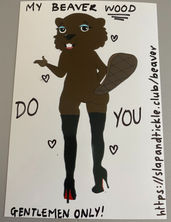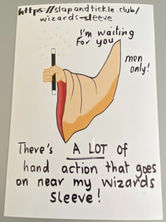Guerrilla Art and Sex Work. (Language and the Female Body)

I will explore the ways in which language is used to describe the female body. I want to explore the different slang terms people use to describe female genitalia through guerrilla art and the euphemisms used in sex work.
Through my work, I want to show how language can be used to objectify and dehumanise women. Language conditions society and leaves an imprint on us all. The words we read, hear, use and see all influence us in some sort of way. I will use my work to create visual representations of the words / slang we use towards women or to describe their bodies. This will highlight the ridiculousness of them and how damaging they can be when understanding our own sexuality. I want to show that understanding/ having ownership of your own body and using the correct language to celebrate it, is powerful and it's something women can choose for themselves rather than have it imposed upon them.
I have taken inspiration from Tart Cards which prostitutes would leave in telephone boxes and other public places to communicate what services they offer and a way to find clients.
Here are my Final Pieces:
Telephone Box:

Tart Cards:

A selection of Tart Cards I made.
My Work Development and Research
Artist Statement
I started my project by wanting to further question why people speak of women as if they are objects or trophies, something they can control. I wanted to understand why people are so demeaning when describing or speaking about women’s bodies. I scrutinize how influential language and communication is in society and how it shapes ideals, opinions, the way we communicate with each other or think about ourselves and others. It encouraged me to examine language (slang terms and phrases) further in relation to female genitalia. Due to the current circumstances we are in at the minute, I think communication is vital as people are not socialising together as much as they’d have done previously.
I began my research by thinking of how many different types of communication are no longer or very rarely used due to technology continually changing. For example, the demand for telephone boxes have been on the decline for many years as majority of people own their own mobile phones nowadays. Telephone boxes are spaces of communication. Prostitutes were known for leaving Tart Cards in telephone boxes from the early 1980’s to 2000’s. They would often advertise what services they offer and usually just include a telephone number.
My vision for this project was to create Guerrilla art in the form of a series of Tart Cards, to create visualise representations of communication and how in an attempt to avoid vulgarity, society uses offensive and degrading language to describe women’s genitalia. As my aim was to place my work in public spaces, I didn’t want it to offend or upset people. I think it is one thing placing thought-provoking artwork in a gallery or studio, where it could be expected but to put it in public spaces is another. This is why I decided to combine childlike, cartoon characters with the slang terms and euphemisms I’ve explored. I researched into the type of language which were used on Tart Cards and found that they very rarely mention sex directly. Even though the images on the cards were graphic and clearly provocative.
Things I think went well throughout my project are my exploration of print making and exploring language, innuendos and slang. I think I was very successful by creating the right amount of playfulness and seriousness in my work. I wanted my Tart Cards to look very light-hearted while having a very serious underlying tone. I think the play on words and innuendos I have included are very effective and create the right balance of humour as well as highlighting the offensive and demeaning slang terms used to describe women's bodies. I didn't want to take away from the main aim of my project as even though the words I use are playful and light-hearted, I wanted it to be clear that it is a lot less fun when reduced to such misogynistic terms. The words I am using are often used by men in a trophy-like way. I feel as though I have very much embraced a more digital take on my work that I initially thought I would. At the beginning of Covid, I dreaded the thought of digital work as I very much worked in 3D only. My previous project has based solely on digital work and in this project, I feel I have been able to combine them both appropriately.
I really enjoyed experimenting with guerrilla art, the experience made me feel terrified and exhilarated at the same time. I felt very cautious of the unsuspecting police officers around and felt the need to sprint away once I’d left a card there. I placed my Tart Cards in various locations such as telephone boxes, park benches, trees, signposts and underneath pub beer mats when people weren’t looking. I created a website for my Tart Cards so when someone found them, they could follow the URL to an anonymous website and the video I made in my previous project would appear. Each different design had its own unique URL (e.g. Beaver, Hairy Handbag, Wizards Sleeve) and you’d only be able to see a certain page depending on which card you found.
I encountered some difficulties throughout my project as I did struggle with some of the printing techniques. I found that they weren’t as crisp and professional-looking as I wanted them to be. They looked messy and too childlike. With this project, I have found that I have spent more time actually producing work instead of researching about my ideas and inspiration which is what I usually do. This did mean, I didn’t look at as much work from other artists as I usually would. I also found that I didn’t balance my work as well as I thought I would have done. I solely focused on the exhibition I was curating instead of my studio practice.
I don’t feel my work has concluded yet and I would like to create more work around this idea to see where I can take it. Overall, I am very pleased with the outcome of my project so far.




























